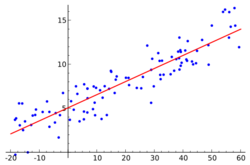DeFries–Fulker regression
| Part of a series on |
| Regression analysis |
|---|
 |
| Models |
| Estimation |
| Background |
|
|
In behavioural genetics, DeFries–Fulker (DF) regression, also sometimes called DeFries–Fulker extremes analysis, is a type of multiple regression analysis designed for estimating the magnitude of genetic and environmental effects in twin studies.[1] It is named after John C. DeFries and David Fulker, who first proposed it in 1985.[2] It was originally developed to assess heritability of reading disability in twin studies, but it has since been used to assess the heritability of other cognitive traits, and has also been applied to non-twin methodologies.[3][4]
Approach
DeFries–Fulker regression analysis is based on the differences in the magnitude of regression to the mean in a genetic trait between monozygotic (MZ) and dizygotic (DZ) twins. In DF regression, the first step is to select probands in a twin study selected with extreme scores on the trait being studied, and to regression to the mean among their co-twins depending on whether the probands are part of a MZ or DZ twin pair. DF regression is thus based on the assumption that, to the extent that genetic factors play a role in causing the extreme variation in the studied trait, the magnitude of regression to the mean should be greater in DZ co-twins of probands than in their MZ counterparts.[5] This should result in MZ co-twins being more similar to their probands on the trait under study than DZ twins are to theirs.[3]
Modifications
Since the DF regression approach was first proposed in 1985, other researchers have proposed modified versions of the DF model that take additional factors into account, including observed covariates[6] and opposite-sex DZ twins.[7]
Regression analysis
The probands are chosen with scores that fall below a "cutoff" for what is considered "extreme", and regression is then used to predict the co-twin scores based on those of the probands and a term reflecting whether the twin pair is MZ (1.0) or DZ (0.5).[8] The formula used for DF regression is:
- C = B1P + B2R + K
where C = expected co-twin score, P = proband score, R = coefficient of relationship (0.5 for DZ twins, 1.0 for MZ twins), and K = regression constant. B1 represents a measure of co-twin relatedness separate from that of zygosity, while B2 can be converted into an estimate of the heritability of extreme scores on the trait.[5] By comparing MZ and DZ co-twins in this manner, an estimate of "group heritability" is generated.[3]
References
- ↑ Rende, Richard; Slomkowski, Cheryl (2005-10-15). "DeFries–Fulker Analysis" (in en). Encyclopedia of Statistics in Behavioral Science. Chichester, UK: John Wiley & Sons, Ltd. doi:10.1002/0470013192.bsa165. ISBN 978-0470860809.
- ↑ DeFries, J. C.; Fulker, D. W. (September 1985). "Multiple regression analysis of twin data" (in en). Behavior Genetics 15 (5): 467–473. doi:10.1007/bf01066239. ISSN 0001-8244. PMID 4074272.
- ↑ 3.0 3.1 3.2 Plomin, Robert; DeFries, John C.; Knopik, Valerie S.; Neiderhiser, Jenae M. (January 2016). "Top 10 Replicated Findings From Behavioral Genetics". Perspectives on Psychological Science 11 (1): 3–23. doi:10.1177/1745691615617439. ISSN 1745-6916. PMID 26817721.
- ↑ Rodgers, Joseph Lee; McGue, Matt (May 1994). "A simple algebraic demonstration of the validity of DeFries–Fulker analysis in unselected samples with multiple kinship levels" (in en). Behavior Genetics 24 (3): 259–262. doi:10.1007/bf01067192. ISSN 0001-8244. PMID 7945155.
- ↑ 5.0 5.1 "DeFries-Fulker multiple regression analysis". University of Colorado Boulder. http://psych.colorado.edu/~willcutt/CLDRC/DFanalysis.htm.
- ↑ Lazzeroni, Laura C.; Ray, Amrita (2012-12-20). "A Generalized Defries–Fulker Regression Framework for the Analysis of Twin Data" (in en). Behavior Genetics 43 (1): 85–96. doi:10.1007/s10519-012-9573-7. ISSN 0001-8244. PMID 23264207.
- ↑ Purcell, S.; Sham, P.C. (2003). "A Model-Fitting Implementation of the DeFries–Fulker Model for Selected Twin Data" (in en). Behavior Genetics 33 (3): 271–278. doi:10.1023/a:1023494408079. ISSN 0001-8244. PMID 12837017.
- ↑ Bishop, D. V. M. (July 2005). "DeFries–Fulker analysis of twin data with skewed distributions: cautions and recommendations from a study of children's use of verb inflections". Behavior Genetics 35 (4): 479–490. doi:10.1007/s10519-004-1834-7. ISSN 0001-8244. PMID 15971028.
 |

